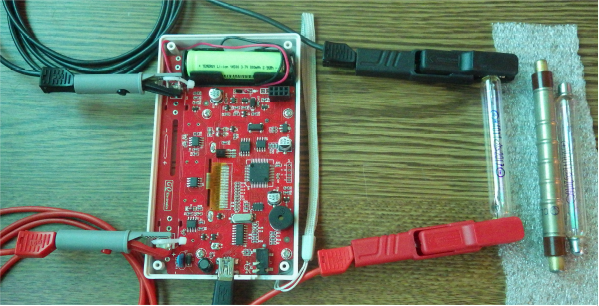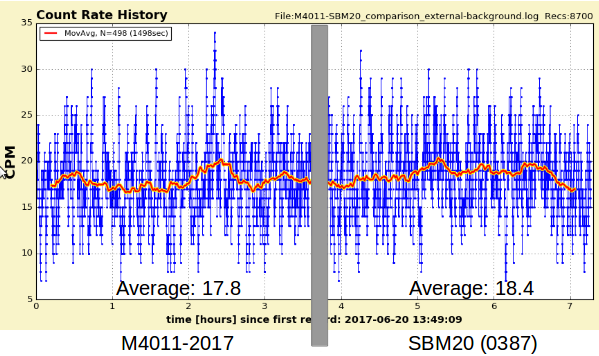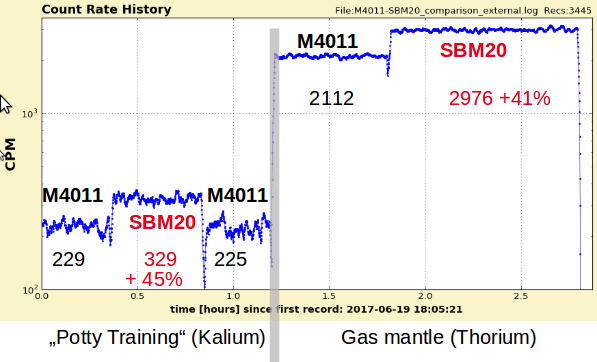| T O P I C R E V I E W |
| ullix |
Posted - 06/21/2017 : 08:00:50
The sensitivity of the tubes is still a bit of a mystery to me, and with rumors abound about a much better SBM20, I decided to get one (from Ukraine via ebay) and test it. This is not a new tube, but several years old, however, supposed to have not been used yet.
Image Insert:

353279 bytes
The picture shows a size comparison of the tubes and the test setup. The SBM20 is 2.0 cm longer than the M4011 (10.8 vs 8.8 cm) so the SBM20 does not fit into the unmodified holding caps in the case (though there are additional soldering points on the circuit board, which may(?) allow a repositioning of the clips to accommodate the SBM20). The diameter of both tubes is 10mm, plus the 5 circular bumps on the SBM20 increasing its diam to 10.8mm.
I preferred not to make any changes to the circuit board and choose the connection via crocodile clips. A bit to my surprise the long test leads did not seem to damage the signal, as I got same results with tube in-situ or extended via cable. (though I did not have an oscilloscope to verify signal shape). But now I could make sure that the two tubes were really seeing the same environment, and differences were not due to difference in distance and/or orientation to the source.
I measured
(done with GeigerLog, http://www.gqelectronicsllc.com/forum/topic.asp?TOPIC_ID=4522):
Image Insert:

114327 bytes
BACKGROUND: While the numbers show a 3% higher background for the SBM20, I think this is within the uncertainty. So, no difference in background.
Image Insert:

54246 bytes
K and Th: Note that the Y-axis is logarithmic to display the 10fold difference in count rate for K of CPM=200...300 vs Th of CPM=2000...3000! Very clearly, the SBM20 does show a 40+% higher count rate!
Both sources are both beta and gamma emitter, but both are predominantly beta emitter. For K it is 90% beta, 10% gamma, but for Th it is not known. It depends on the age since last chemical purification of Th, which then resulted in the build-up of the decay chain over some years. However, testing with several thin sheets of steel inserted between source and detector and observing damping of count rate has confirmed that it is also a strong beta emitter, but does have some gamma component.
Overall, the SBM20 has the same background as the M4011, but is 40+% more sensitive to counts as long as the source has a strong beta component. Whether the difference extends to gamma is not known and cannot be told with these experiments.
|
| 3 L A T E S T R E P L I E S (Newest First) |
| ptalev |
Posted - 11/06/2020 : 12:49:58
But wich is true,high sensitivity sbm20 or m4011
quote:
Originally posted by ullix
The sensitivity of the tubes is still a bit of a mystery to me, and with rumors abound about a much better SBM20, I decided to get one (from Ukraine via ebay) and test it. This is not a new tube, but several years old, however, supposed to have not been used yet.
Image Insert:

353279 bytes
The picture shows a size comparison of the tubes and the test setup. The SBM20 is 2.0 cm longer than the M4011 (10.8 vs 8.8 cm) so the SBM20 does not fit into the unmodified holding caps in the case (though there are additional soldering points on the circuit board, which may(?) allow a repositioning of the clips to accommodate the SBM20). The diameter of both tubes is 10mm, plus the 5 circular bumps on the SBM20 increasing its diam to 10.8mm.
I preferred not to make any changes to the circuit board and choose the connection via crocodile clips. A bit to my surprise the long test leads did not seem to damage the signal, as I got same results with tube in-situ or extended via cable. (though I did not have an oscilloscope to verify signal shape). But now I could make sure that the two tubes were really seeing the same environment, and differences were not due to difference in distance and/or orientation to the source.
I measured
(done with GeigerLog, http://www.gqelectronicsllc.com/forum/topic.asp?TOPIC_ID=4522):
Image Insert:

114327 bytes
BACKGROUND: While the numbers show a 3% higher background for the SBM20, I think this is within the uncertainty. So, no difference in background.
Image Insert:

54246 bytes
K and Th: Note that the Y-axis is logarithmic to display the 10fold difference in count rate for K of CPM=200...300 vs Th of CPM=2000...3000! Very clearly, the SBM20 does show a 40+% higher count rate!
Both sources are both beta and gamma emitter, but both are predominantly beta emitter. For K it is 90% beta, 10% gamma, but for Th it is not known. It depends on the age since last chemical purification of Th, which then resulted in the build-up of the decay chain over some years. However, testing with several thin sheets of steel inserted between source and detector and observing damping of count rate has confirmed that it is also a strong beta emitter, but does have some gamma component.
Overall, the SBM20 has the same background as the M4011, but is 40+% more sensitive to counts as long as the source has a strong beta component. Whether the difference extends to gamma is not known and cannot be told with these experiments.
|
| ptalev |
Posted - 11/06/2020 : 05:16:27
Hi.Im new here, i have gq gmc320+v4 and looking for more info about sbm20 tube and convrersion ,find this on another forum.
Conversion rate for SBM-20 --> 0.0057 Calculations: uranium glass bead 238U : SBM-20 --> 290cpm * 0.0057 = 1.653ÁSv/h M4011 --> 1.653ÁSv/h / 245cpm = 0.0067469387755102 uranium ore 238U : SBM-20 --> 471cpm * 0.0057 = 2.6847ÁSv/h M4011 --> 2.6847ÁSv/h / 436cpm = 0.0061575688073394 smoke detector pellet 241Am : SBM-20 --> 896cpm * 0.0057 = 5.1072ÁSv/h M4011 --> 5.1072ÁSv/h / 790cpm = 0.0064648101265823 lantern mantle 232Th full size: SBM-20 --> 5253cpm * 0.0057 = 29.9421ÁSv/h M4011 --> 29.9421ÁSv/h / 4386cpm = 0.0068267441860465 Averaging: 0.0067469387755102 + 0.0061575688073394 + 0.0064648101265823 + 0.0068267441860465 = 0.0261960618954784 0.0261960618954784 / 4 = 0.0065490154738696 0.0065490154738696 <-- rounding to 4 digits behind the dot --> 0.0066 <-- Theoretical conversion rate for the M4011 after applying maths. :) Hope this helped out. :)
Best regards |
| Franglish9265 |
Posted - 05/20/2019 : 19:27:45
...bump...
quote:
Originally posted by ullix
The sensitivity of the tubes is still a bit of a mystery to me, and with rumors abound about a much better SBM20, I decided to get one (from Ukraine via ebay) and test it. This is not a new tube, but several years old, however, supposed to have not been used yet.
Image Insert:

353279 bytes
The picture shows a size comparison of the tubes and the test setup. The SBM20 is 2.0 cm longer than the M4011 (10.8 vs 8.8 cm) so the SBM20 does not fit into the unmodified holding caps in the case (though there are additional soldering points on the circuit board, which may(?) allow a repositioning of the clips to accommodate the SBM20). The diameter of both tubes is 10mm, plus the 5 circular bumps on the SBM20 increasing its diam to 10.8mm.
I preferred not to make any changes to the circuit board and choose the connection via crocodile clips. A bit to my surprise the long test leads did not seem to damage the signal, as I got same results with tube in-situ or extended via cable. (though I did not have an oscilloscope to verify signal shape). But now I could make sure that the two tubes were really seeing the same environment, and differences were not due to difference in distance and/or orientation to the source.
I measured
(done with GeigerLog, http://www.gqelectronicsllc.com/forum/topic.asp?TOPIC_ID=4522):
Image Insert:

114327 bytes
BACKGROUND: While the numbers show a 3% higher background for the SBM20, I think this is within the uncertainty. So, no difference in background.
Image Insert:

54246 bytes
K and Th: Note that the Y-axis is logarithmic to display the 10fold difference in count rate for K of CPM=200...300 vs Th of CPM=2000...3000! Very clearly, the SBM20 does show a 40+% higher count rate!
Both sources are both beta and gamma emitter, but both are predominantly beta emitter. For K it is 90% beta, 10% gamma, but for Th it is not known. It depends on the age since last chemical purification of Th, which then resulted in the build-up of the decay chain over some years. However, testing with several thin sheets of steel inserted between source and detector and observing damping of count rate has confirmed that it is also a strong beta emitter, but does have some gamma component.
Overall, the SBM20 has the same background as the M4011, but is 40+% more sensitive to counts as long as the source has a strong beta component. Whether the difference extends to gamma is not known and cannot be told with these experiments.
|
|
|

